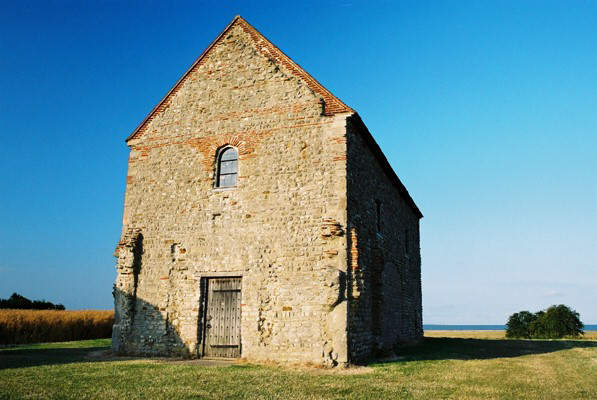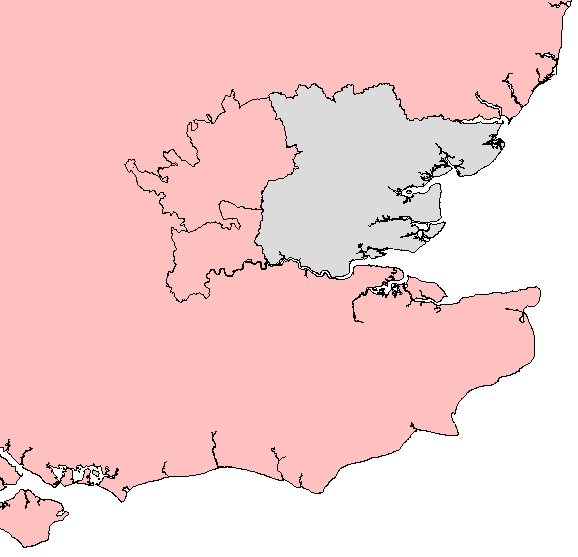|
Swithelm Of Essex
Swithhelm was King of Essex from 660 to 664. Swithhelm succeeded King Sigeberht II after he, along with his brother Swithfrith, murdered him. They accused him of being too friendly toward Christians Christians () are people who follow or adhere to Christianity, a monotheistic Abrahamic religion based on the life and teachings of Jesus Christ. The words ''Christ'' and ''Christian'' derive from the Koine Greek title ''Christós'' (Χρ .... In 662, however, he was persuaded to convert to Christianity by Aethelwald, king of East Anglia. After his death in 664, he was succeeded by his cousins Sighere and Sebbi. External links * 664 deaths Converts to Christianity from pagan religions East Saxon monarchs 7th-century English monarchs Year of birth unknown {{UK-royal-stub ... [...More Info...] [...Related Items...] OR: [Wikipedia] [Google] [Baidu] |
Sigeberht II Of Essex
Sigeberht II, nicknamed the Good (''Bonus'') or the Blessed (''Sanctus''), was King of the East Saxons (r. ''c''. 653 to ? 660 x 661), in succession to his relative Sigeberht I the Little. Although a bishopric in Essex had been created under Mellitus, the kingdom had lapsed to paganism and it was in Sigeberht's reign that a systematic (re-)conversion of the East Anglians took root. Bede's ''Historia Ecclesiastica'', Book III, chapter 22, is virtually the sole source for his career. Family Apart from referring to the odd kinsman, Bede offers little that is of help in determining Sigeberht's family connections. Additional evidence is provided by genealogies for Offa, Swithred and Sigered in a 9th-century West-Saxon manuscript and in two post-Conquest sources: William of Malmesbury's ''Gesta regum'' and John of Worcester's ''Chronicon ex Chronicis'', the latter including a memorandum (''Chronicon'' A) and a genealogical list (''Chronicon'' B). Their testimony is at times confused ... [...More Info...] [...Related Items...] OR: [Wikipedia] [Google] [Baidu] |
Christians
Christians () are people who follow or adhere to Christianity, a monotheistic Abrahamic religion based on the life and teachings of Jesus Christ. The words ''Christ'' and ''Christian'' derive from the Koine Greek title ''Christós'' (Χριστός), a translation of the Biblical Hebrew term ''mashiach'' (מָשִׁיחַ) (usually rendered as ''messiah'' in English). While there are diverse interpretations of Christianity which sometimes conflict, they are united in believing that Jesus has a unique significance. The term ''Christian'' used as an adjective is descriptive of anything associated with Christianity or Christian churches, or in a proverbial sense "all that is noble, and good, and Christ-like." It does not have a meaning of 'of Christ' or 'related or pertaining to Christ'. According to a 2011 Pew Research Center survey, there were 2.2 billion Christians around the world in 2010, up from about 600 million in 1910. Today, about 37% of all Christians live in the A ... [...More Info...] [...Related Items...] OR: [Wikipedia] [Google] [Baidu] |
Æthelwold Of East Anglia
Æthelwold, also known as Æthelwald or Æþelwald (Old English: ''Æþelwald'' "noble ruler"; reigned c. 654 – 664), was a 7th-century king of East Anglia, the long-lived Anglo-Saxon kingdom which today includes the English counties of Norfolk and Suffolk. He was a member of the Wuffingas dynasty, which ruled East Anglia from their ''regio'' (centre of royal authority) at Rendlesham. The two Anglo-Saxon cemeteries at Sutton Hoo, the monastery at Iken, the East Anglian see at Dommoc and the emerging port of Ipswich were all in the vicinity of Rendlesham. Æthelwold lived during a time of political and religious upheaval in East Anglia, whose Christian kings in the decades prior to his succession all died violent deaths, having proved unequal to the task of defending the newly converted kingdom against attacks from its neighbouring kingdom, Mercia, led by its pagan king, Penda. Æthelwold was the last of the nephews of Rædwald to rule East Anglia. He died in 664 and was ... [...More Info...] [...Related Items...] OR: [Wikipedia] [Google] [Baidu] |
Sighere Of Essex
Sighere was the joint king of the Kingdom of Essex along with his cousin Sæbbi from 663/4 to about 688. He was son of Sigeberht Sæwarding, probably Saint Sigeberht, but perhaps Sigeberht the Little. He was outlived by Sæbbi, who became the sole ruler of Essex after his death. Sighere and Sæbbi were cousins of their predecessor Swithelm. While Sighere returned to paganism, Sæbbi remained Christian. They soon developed a rivalry. Sighere found an ally in Wessex, and Sæbbi with Mercia. As a result of their rivalry, King Wulfhere of Mercia established himself as overlord of Essex. and induced Sighere to marry his niece Osgyth, daughter of Frithuwold, sub-king of Mercia in Surrey. Jaruman, the bishop of Mercia, was assigned to reconvert the people of Essex to Christianity. In 673, Sighere separated from Osgyth, who then fled to the protection of Bishop Beaduwine of North Elmham North Elmham is a village and civil parish in the English county of Norfolk. It cover ... [...More Info...] [...Related Items...] OR: [Wikipedia] [Google] [Baidu] |
Kingdom Of Essex
la, Regnum Orientalium Saxonum , conventional_long_name = Kingdom of the East Saxons , common_name = Essex , era = Heptarchy , status = , status_text = , government_type = Monarchy , event_start = , date_start = , year_start = 527 , event_end = , date_end = , year_end = 825 , event1 = , date_event1 = , event2 = , date_event2 = , event3 = , date_event3 = , event4 = , date_event4 = , p1 = Sub-Roman Britain , flag_p1 = Vexilloid of the Roman Empire.svg , border_p1 = no , s1 = Kingdom of England , flag_s1 = Flag of Wessex.svg , border_s1 = no , image_flag = , flag = , flag_type = , image_ ... [...More Info...] [...Related Items...] OR: [Wikipedia] [Google] [Baidu] |
664 Deaths
__NOTOC__ Year 664 ( DCLXIV) was a leap year starting on Monday (link will display the full calendar) of the Julian calendar. The denomination 664 for this year has been used since the early medieval period, when the Anno Domini calendar era became the prevalent method in Europe for naming years. Events By place North America & Europe * 1 May – A solar eclipse affects areas along a line from Central America, through eastern North America, the North Atlantic, Ireland, Britain and Germany. (access: 10 November 2016).Josiah Cox Russell, 1976, "The earlier medieval plague in the British Isles", ''Viator'' vol. 7, pp. 65–78. Britain & Ireland * |
Converts To Christianity From Pagan Religions
Religious conversion is the adoption of a set of beliefs identified with one particular religious denomination to the exclusion of others. Thus "religious conversion" would describe the abandoning of adherence to one denomination and affiliating with another. This might be from one to another denomination within the same religion, for example, from Baptist to Catholic Christianity or from Sunni Islam to Shi’a Islam. In some cases, religious conversion "marks a transformation of religious identity and is symbolized by special rituals". People convert to a different religion for various reasons, including active conversion by free choice due to a change in beliefs, secondary conversion, deathbed conversion, conversion for convenience, marital conversion, and forced conversion. Proselytism is the act of attempting to convert by persuasion another individual from a different religion or belief system. Apostate is a term used by members of a religion or denomination to refer ... [...More Info...] [...Related Items...] OR: [Wikipedia] [Google] [Baidu] |
East Saxon Monarchs
East or Orient is one of the four cardinal directions or points of the compass. It is the opposite direction from west and is the direction from which the Sun rises on the Earth. Etymology As in other languages, the word is formed from the fact that east is the direction where the Sun rises: ''east'' comes from Middle English ''est'', from Old English ''ēast'', which itself comes from the Proto-Germanic *''aus-to-'' or *''austra-'' "east, toward the sunrise", from Proto-Indo-European *aus- "to shine," or "dawn", cognate with Old High German ''*ōstar'' "to the east", Latin ''aurora'' 'dawn', and Greek ''ēōs'' 'dawn, east'. Examples of the same formation in other languages include Latin oriens 'east, sunrise' from orior 'to rise, to originate', Greek ανατολή anatolé 'east' from ἀνατέλλω 'to rise' and Hebrew מִזְרָח mizraḥ 'east' from זָרַח zaraḥ 'to rise, to shine'. ''Ēostre'', a Germanic goddess of dawn, might have been a personification ... [...More Info...] [...Related Items...] OR: [Wikipedia] [Google] [Baidu] |
7th-century English Monarchs
The 7th century is the period from 601 (DCI) through 700 ( DCC) in accordance with the Julian calendar in the Common Era. The spread of Islam and the Muslim conquests began with the unification of Arabia by Muhammad starting in 622. After Muhammad's death in 632, Islam expanded beyond the Arabian Peninsula under the Rashidun Caliphate (632–661) and the Umayyad Caliphate (661–750). The Muslim conquest of Persia in the 7th century led to the downfall of the Sasanian Empire. Also conquered during the 7th century were Syria, Palestine, Armenia, Egypt, and North Africa. The Byzantine Empire suffered setbacks during the rapid expansion of the Caliphate, a mass incursion of Slavs in the Balkans which reduced its territorial limits. The decisive victory at the Siege of Constantinople in the 670s led the empire to retain Asia Minor which assured the existence of the empire. In the Iberian Peninsula, the 7th century was known as the ''Siglo de Concilios'' (century of counc ... [...More Info...] [...Related Items...] OR: [Wikipedia] [Google] [Baidu] |




.jpg)
